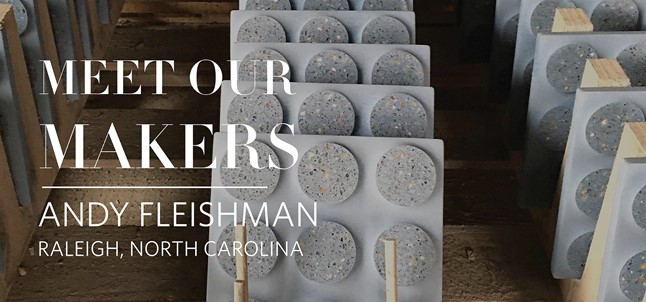
Andy Fleishman has been designing concrete tile for Ann Sacks for nearly 20 years. But he’s also a painter, a sculptor—and a onetime science consultant. Here’s his story.


How did you get your start in the art world?
I lived in Nova Scotia—a without-electricity kind of thing—for seven years back in the ’70s. Canada had a program that would train you for anything that would give you something to live on. I signed up for a furniture-making course near Halifax, and the teacher was really excellent. I decided to make a serpentine cherry wood–fronted chest of drawers with carving on it. I immediately got into the Nova Scotia Museum’s annual craft show.
Then I moved to the rural belt between Chapel Hill and Durham and started doing some work on houses. I worked on a house in Chatham County, and the guy wanted everything to be handmade. Even the handle that controlled the water coming out of the sink was a carved wooden piece. That house made it into a book about handmade houses. I decided I was going to be an artist.

I made sculpture and had a one-person show pretty quickly, and that got a lot of publicity. I did stuff that eventually wound up in the Allan Stone Gallery in New York. I was in the art world for a long time, and it always seemed like people who made it had to have a certain personality type. But I’ve always made it in more of a quirky way.

What precipitated the transition to making tile?
I started getting real interested in triangles and how you could make hexagons out of them—how you could make any kind of freehand drawing inside the triangle and do a mirror image and make a hexagon. Hexagons, for whatever reason, seemed to reveal themselves to me easily. This was in 1998, before I had a computer, so I would draw one and bring it to the copy store and get a mirror image made and tape it together. Eventually, I got a computer and just took a flash drive in, and they would print it. This was early art; I didn’t know what it would end up being.
At that time, I was using cement in a lot of different ways, and my wife picked up some and started troweling it into stepping stones shaped like cats. She took some to a store, and they started selling them. She wound up getting them into national mail-order catalogs. Meanwhile, I met a scientist at a party who worked at the Chemical Industries Institute of Technology. He asked if I wanted to be a consultant to help do nasal-airflow studies, even though I didn’t have a science background. It turned into a real collaboration between art and science.
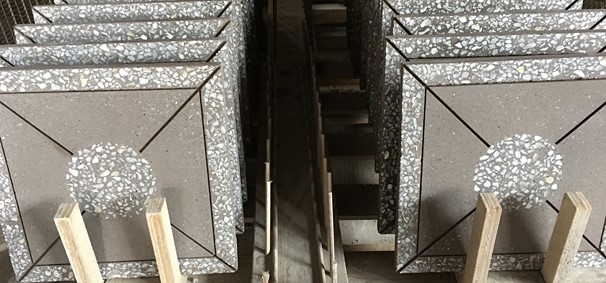
So I’m doing this incredibly sophisticated casting for the Institute, and my wife is troweling cement, and it occurred to me that I should develop a little casting in the studio. So I did. I started making illusionistic stuff that looked like corrugated cardboard and Styrofoam. This is what ended up in the Allan Stone Gallery. I also started making cast-concrete tabletops with a relief pattern filled with a different color that I would sand down so it was all very smooth. A friend of mine who was an artist in Durham moved to Miami and was designing interiors and making bannisters and all kinds of handmade stuff. We talked, and I realized, I could do cast concrete with tile. He thought it was great and ordered quite a large amount for a big house in Miami.
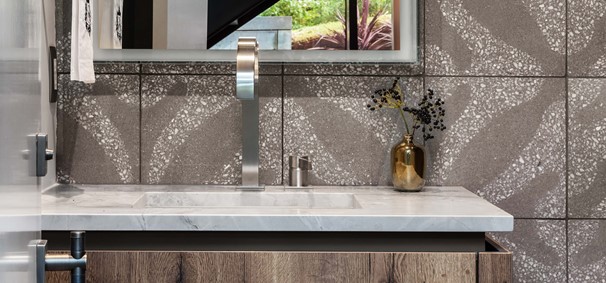
How did you start making tiles for Ann Sacks?
We did a few more projects, and then my friend suggested I reach out to Ann Sacks. I had a sanded, polished tile, and it was extremely elegant and beautiful. I sent it to the president of the company. He was enthusiastic and gave it to the head of new-product development, DeeDee, and she also wanted to do it.
Going from that first tile to an actual product, I was impressed with Ann Sacks. They were very understanding about me being an artist trying to turn a piece of art into a product that would work in their system with all the different showrooms. They wanted to be on the cutting edge.
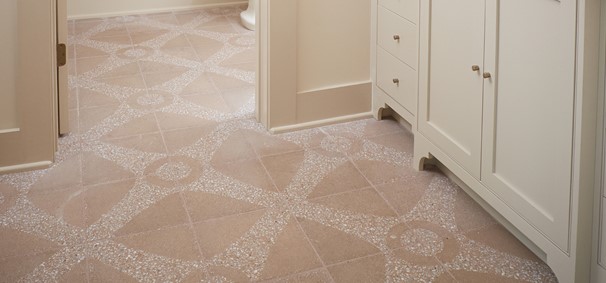
Where are your tiles made now?
I was making the tiles here in my studio for 14 years. North Carolina State, since it was originally an agricultural school, had a service where people like me could get an expert opinion. They had a facility that was built to test concrete, a pretty big building with a 3-foot-thick floor. About five years ago, I met the person running it. And one day, out of the blue, he said he and his wife were interested in producing my tiles. He has a Ph.D. in cement, and he’s an engineer. It couldn’t be more perfect to have him as a consultant and his wife running the production.

You have three lines—Andy Fleishman, Andy Fleishman Neo Terrazo, and Geode by Andy Fleishman—and a fourth on the way. What’s the inspiration behind them?
One of the first hexagon drawings I ever did ended up being Maximus, one of my first tiles for Ann Sacks—and one of the most popular ones. That always felt really great, that it was pure artistry, and it’s spread all over the world. Two years ago, there was a big order from China for Maximus for a five-star hotel on top of one of the 10 tallest buildings in the world. That was an exciting thing for something I made in my studio.
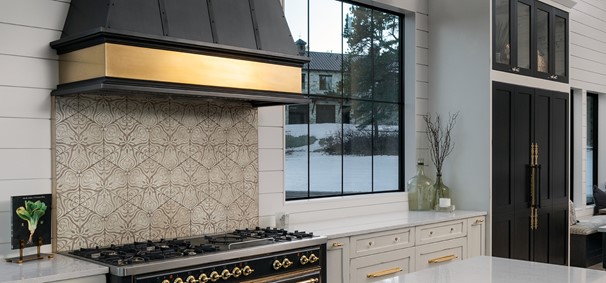
Geode came about when Deedee asked me to make cement wall tiles that were dimensional. I made some, and she said, this should be a line. And she was right. Geode is such a great name for it, because basically you’re looking into the surface of something, and then there’s that polished part.
At one point I kind of said, “I’m going to not worry about tile for a little while, and I’ll make something that doesn’t seem like it’ll work for a tile.” And I ended up designing Fantastique for Ann Sacks. The border between art and design is porous, and I don’t want to make it really distinct.






























